Photo




True Blue Flowers at the allotment /part 2
I’ve complained over and over about how I missed having the time to write and share plant stuff, but it feels so odd I’m now back at it only because we’re on quarantine, and suddenly have ALL the time I could possibly need.
This said, I thought I’d go on with the true blue flowers series I started many moons ago, so here you have two plants I bought last summer in the garden centre where I work. They are unrelated, but the colour of their flowers matched in a lovely way.
The first is Salvia patens ‘Cambridge Blue’, or gentian sage, a gorgeous cultivar of the Mexican herbaceous perennial species. It flowers profusely through summer well into autumn forming a neat, aromatic clump and it’s best treated like a dahlia, lifting the fleshy tuberous root system before winter and storing it away from hard frost. Bees obviously love the large lipped flowers.
The second is Delphinium grandiflorum ‘Summer Blues’, or Siberian larkspur, a short-lived herbaceous perennial much different from the large and sturdy larkspurs part of the D. elatum species. It doesn’t grow much taller than 30 or 40 cm and both foliage and flowers are quite dainty, but extremely vibrant. The blossoms, opening over several weeks through summer, look as if they had been painted with watercolours and go on to produce a good number of seeds to ensure self-sowing.
#blue flowers#salvia patens cambridge blue#gentian sage#lamiaceae#delphinium grandiflorum summer blues#siberian larkspur#ranuncolaceae#horticulture#botany#allotment gardening#plantblr#gardeners on tumblr#scotland#plants
92 notes
·
View notes
Photo

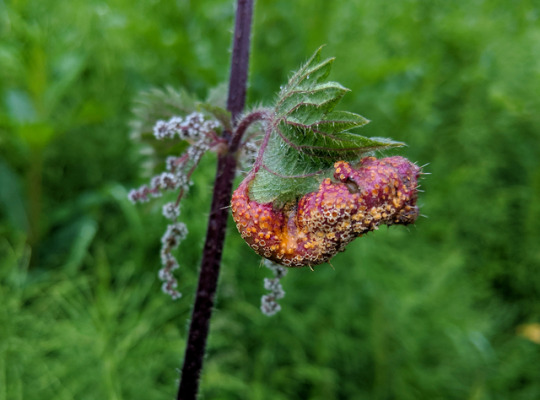

Puccinia urticata on Urtica dioica
It’s hard to walk by banks covered in common nettle without noticing this fiery and gruesome rust fungus taking hold of and deforming the plant’s limbs.
It’s best described as a species complex with a life cycle which might alternate between two hosts- in the British Isles often a nettle (U. dioica or U. urens) and a sedge (mostly Carex sp.), but its ‘sub-species’ can also be found on Aster and Ribes.
Here you can see some beautiful up-close photos of its structures.
#puccinia urticata#rust fungus#basidiomycota#fungi#mycology#urtica dioica#common nettle#urticaceae#botany#plant pathogens#scotland#plantblr#gardeners on tumblr#plants
63 notes
·
View notes
Photo
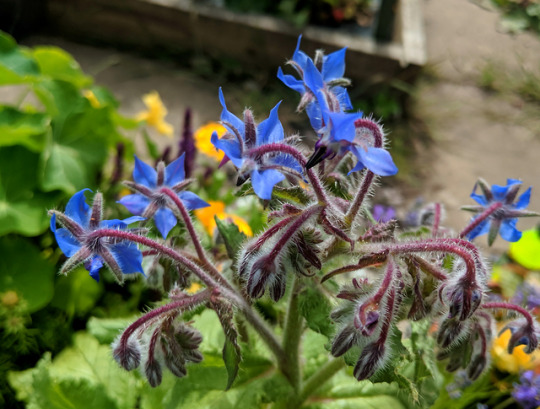


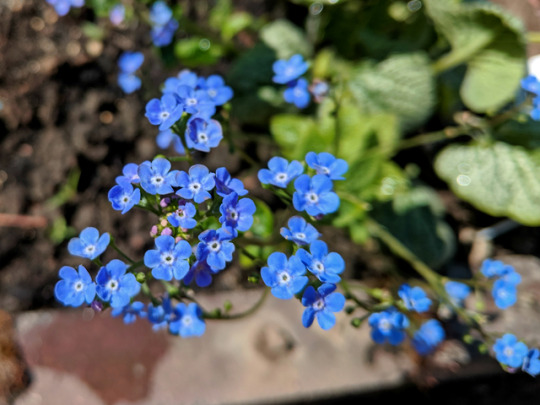
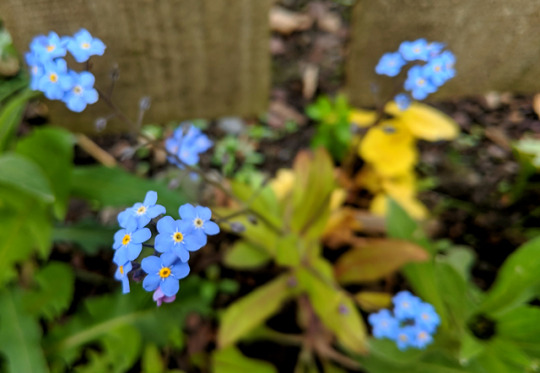

True Blue Flowers at the allotment /part 1
You know I love blue flowers, but you might have not noticed how uncommon ‘true blue’ flowers actually are in nature. In the animal world, the presence of this colour is often just an optical effect caused by how light is absorbed and refracts in particular structures. In plants, however, different shades of real blue are the result of chemical changes that alter the red and purple anthocyanin pigments present in a large variety of species.
This is not a common process and it has proven to be particularly challenging to replicate artificially. If you like technical details, here you can read about how the first -passably- blue Chrysanthemum was created.
Some plant families though, seem to have mastered this prodigious alchemical feat and produced a good variety of sky-coloured species, which have been further diversified artificially in as many cultivars. Probably the most prominent of these families, the Boraginaceae has gifted us with some of the most common blue wildlfowers you could encounter in temperate areas, and plenty of garden ornamental plants.
In the photos above you can see members of this family currently blooming at my veg plot and, if you look closely, you can see how the flower buds on all these plants look pink, but the pigments start changing as they open to reveal different shades of true blue:
- Borago officinalis, borage: annual herbaceous
- Lithodora diffusa ‘Blue Star’ & ‘Heavenly Blue’: evergreen subshrubs
- Brunnera macrophylla ‘Jack Frost’, Siberian bugloss: deciduous herbaceous perennial
- Myosotis scorpioides, water forget-me-not: herbaceous perennial
- Myosotis arvensis, field forget-me-not: herbaceous annual or short-lived perennial
Now check back in a few years please, I’m on my way to holding the national collection of Boraginaceae and the largest variety of blue flowers in one garden ;)
#flowers#blue flowers#boraginaceae#borago officinalis#lithodora diffusa#myosotis scorpioides#myosotis arvensis#plant science#horticulture#botany#plantblr#gardeners on tumblr#scotland#summer#allotment gardening#cottage garden#vegetable plot
79 notes
·
View notes
Photo







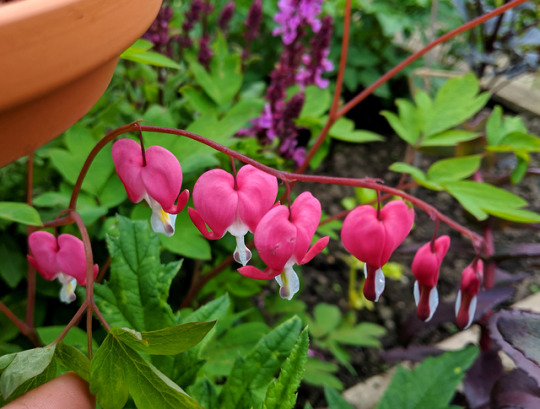

Spring flowers at the allotment
Since I’ve been behind, so, so behind with sharing photos of my plot, here’s a collection of spring flowers, with more to come as they couldn’t all fit in a post.
I will be writing more specifically about some of the plants I’ve grown, but for the moment I still have some work to do as I might have entered the plot into a local gardening contest to be judged soon…stay tuned!
#spring flowers#allotment gardening#cottage garden#vegetable garden#daffodils#narcissus#lithodora#erysimum#silene#ajuga#aquilegia#lewisia#antirrhinum#heuchera#dicentra#salvia#iris#clematis#fragaria#plantblr#gardeners on tumblr#botany#plants#flowers#scotland#spring
181 notes
·
View notes
Photo

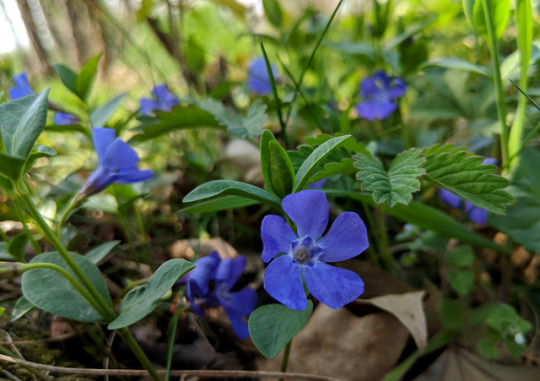

Vinca minor, Apocynaceae
Lesser periwinkle was another of the groundcover species I found in the lightly shaded dry ditch running along a row of Lombardy poplars (Populus nigra ‘Italica’) edging a field.
This creeping evergreen plant native to much of Europe and the Eastern Mediterranean region is a beauty in the spring and early summer months, with its propeller-shaped flowers in a particular shade of violet-blue -which has given the name to the periwinkle colour- poking through the dark, leathery foliage.
Although its vigorous habit and ability to thrive in most soils can make it an invasive species in the wrong place, it is a really valuable ornamental plant and numerous cultivars have been selected. Here are three currently in bloom at the garden centre where I work:

V. minor ‘Ralph Shugert’, named after the Michigan nurseryman who selected it, has large flowers and variegated foliage, with a thin creamy-yellow edge and veining. Some shoots grow completely albino.

V. minor ‘Illumination’, with foliage splashed with chartreuse-yellow, often taking the entire centre of the leaf. A good groundcover plant to brighten up a shadier corner where not much else grows well.
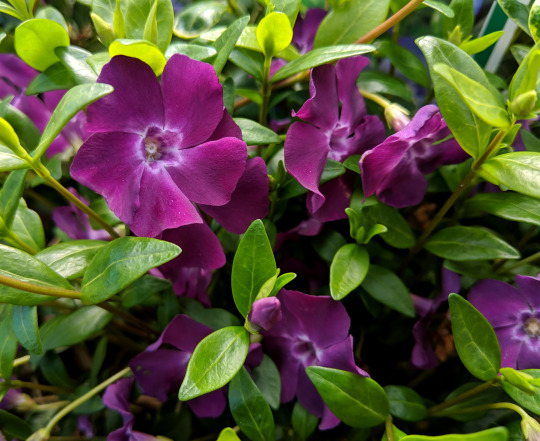
V. minor ‘Atropurpurea’, as the name suggests, produces flowers in a darker, warmer shade of purple contrasting well with the glossy green foliage.
#vinca minor#lesser periwinkle#creeping myrtle#apocynaceae#evergreen groundcover#wildflowers#horticulture#botany#plantblr#gardeners on tumblr#garden centre#my job#italy#countryside#scotland
79 notes
·
View notes
Text
I can’t believe it’s already been over a month since the last time I posted, I swear I’d love to be consistent and there have been countless times I’ve taken photos looking forward to write about what I’d seen, but I’ve been so short of time, that’s just it.
I’m planning on continuing with all the series I started -I’m already so behind I’d have material to write five posts a day...- and I can’t wait to finally show you more of what I’ve done with the allotment, now that a whole winter of planning and so much work are finally showing results.
While I wasn’t posting I’ve also turned 29, which feels just weird, and a special furball is now living with us: meet His Royal Cuteness, wee Haggis the Jug

39 notes
·
View notes
Text
Since the awesome John @treemigration tagged me, I feel obliged to attempt this, but I suck at these things as I’ve always failed to understand how people can decide they favour something out of anything else in the same category. I’m the kind of person who panics when presented with the question “what’s your favourite x?”. But let’s try.
Favorite Plant: I....like them all :| They are all equally interesting to me, hence my obsession with them. Also, there are so many plants we still have to describe I couldn’t possibly make a choice out of an indefinite group, sorry. But today I bought a Lithodora ‘Heavenly Blue’ and I love it.

Favorite Color: I’d say green, but my brain would start screaming LIAR!! Because I’m more of a combination-of-colours kind of person. If you follow my blog you probably know I love blue-yellow-green-white, it’s my go-to for plant schemes. But I’m also really partial to gradients going yellow-orange-pink/red.
Favorite Hobby: Has to be gardening, which is also my job and how I spend most of my time, but I’m also a bookworm (I love science fiction, historical fiction, fantasy, manuals and encyclopedias). I’ve always loved writing, but now I mostly write on this blog as time is precious. Before I finished university I hardly went a day without drawing, but I don’t seem to find enough time now. I have the physical need to create things with my hands, but never settled on a particular craft as I love to learn new things. Finally, I could go for a hike every day of my life if I could, but I can’t.
Useless fact about yourself: I’m one of those people who can wave their belly. As a kid I enjoyed the power of grossing out others.
Favorite Band: I don’t have one...
Favorite Music Genre: I have two opera singers on one side of the family, my granny taught me operas word by word when I was in nursery (my fave will always be Tosca by Giacomo Puccini), while my uncle has a recording studio where he produces mostly rock, he gave me a guitar when I was young and I started playing and singing, I had a short-lived rock group in high school. I can honestly appreciate most music.
Favorite Field Guide/Key: “Segreti e virtù delle piante medicinali” which translates as “Secrets and virtues of medicinal plants” from Italian. It was one of my cousin’s books when he studied pharmacy and I got a hold of it when I was 5 or 6, it’s still with me here in Scotland. I love this book and its beautiful photos and watercolour botanical illustrations.

Micro or Macro: Both, you can’t appreciate the meaning of either taken alone.
Since @treemigration has already tagged a lot of people i follow, I’ll tag some others who come to mind, but do as you wish: @ortopriamo, @hortushorrei, @stefano-bonalume, @agavex, @troyjakob, @rumade, @notjosereally, @indelliblemercinary, @underthehedge, @microcosmicx, @seedkeeping
47 notes
·
View notes
Photo



Lamium purpureum, Lamiaceae & Anemone nemorosa, Ranuncolaceae
I have already written about the delicate wood anemone before, but never about the ever so common purple dead-nettle: I generally try to single plants out for photos, but couldn’t walk away from this gorgeous combination.
On the sloping side of a dry irrigation ditch, in the dappled shade of a row of tall trees, the anemone’s dissected foliage was covering the ground in a dense mat, out of which were poking the bright pink lipped flowers of the dead-nettle.
The reason why this herbaceous perennial bears that common name is due to the superficial similarity between its leaves and those of the unrelated stinging nettle (Urtica dioica), however its hairs won’t cause any harm. The top part of the plant is generally a rich burgundy-purple colour, hence the other part of the common name and the species name, but it is a variable plant and looks just green when growing in a more shady position, as in these photos.
It is often considered an undesirable plant in a garden setting, some might call it a “weed”, but I let it grow in my allotment for two main reasons. It’s in bloom from early spring often until late autumn, sometimes even longer in a sheltered position, and its flowers are loved by pollinators, especially bumblebees. Its young shoots are also edible and it’s a pot herb with an interesting flavour, so I see it as a bonus leaf vegetable.
#lamium purpureum#lamiaceae#purple dead-nettle#anemone nemorosa#ranuncolaceae#wood anemone#windflower#wildflowers#plantblr#horticulture#botany#gardeners on tumblr#edible plants#italy#spring
72 notes
·
View notes
Photo




Chelidonium majus, Papaveraceae
One of the wildflowers I strongly associate with my childhood and learnt to recognise early, I hadn’t seen so much greater celandine in full bloom in years, but probably I just visit home, in Italy, too late in the summer to enjoy the full show.
This herbaceous perennial from the poppy family, native to the Mediterranean, temperate Europe and Western Asia, has been known and used for its medicinal properties since antiquity, and for that reason it was introduced in many areas outside of its natural range. Although reportedly naturalised around settlements, I still have to spot it here up north in Scotland.
Due to its ability to quickly colonise disturbed sites and the edge of woodland, it can prove rather invasive after introduction. For instance, It seems to be present throughout the north-eastern portion of the US and listed as invasive in Wisconsin.
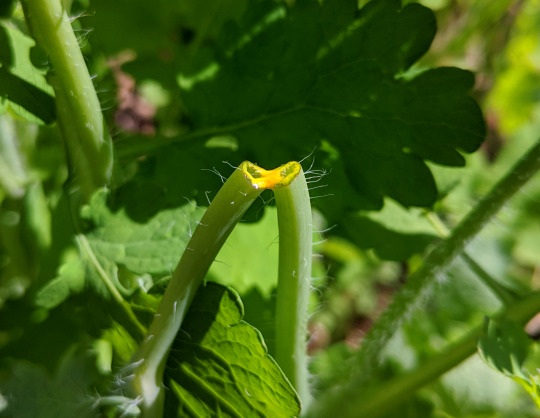
One thing I vividly remember learning as a kid is the traditional use of its yellow latex to “burn” warts and skin cancer and to thin calluses. Please don’t try it though, the latex is an irritant and can cause allergic reactions, while the whole plant is mildly toxic.
#chelidonium majus#greater celandine#nipplewort#papaveraceae#wildflowers#horticulture#botany#plantblr#gardeners on tumblr#plants#spring#italy#countryside
46 notes
·
View notes
Photo



Ajuga reptans, Lamiaceae
However common and widespread bugle might be across Europe and the British Isles, I don’t recall ever seeing it in the wild before finding three colonies on the edge of a field near my hometown in northern Italy, and I would remember because I just love its dense racemes of blue flowers. Due to its creeping habit and small leaves, it’s definitely easy to miss unless in bloom though.
It’s evergreen, forms a dense groundcover, flowers beautifully for a few months attracting wildlife and it’s extremely tolerant of full shade and moist ground, so I’ve lost count of the times I’ve invited customers to try it in difficult, dark spots where little else would thrive. Here below are a couple of common cultivars currently in bloom at the garden centre where I work:
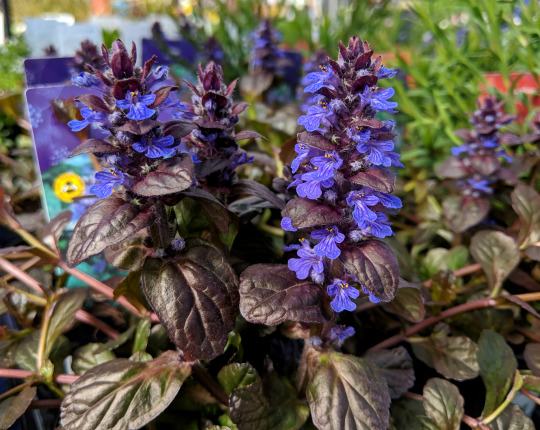
A. reptans “Braunherz” has dark, purply foliage and stems which provide amazing contrast to the flowers. Seems to do well even with prolonged, hard frost and in full sun. I have some growing at my allotment and it’s just beginning to flower.

A. reptans “Burgungy Glow” has foliage variegated in cream and pink, with dark, bluish flower stems. Not as tolerant of the extremes, as often happens with variegated varieties. The flower spikes make me think of a picture to which the “invert” filter has been applied, as if the flowers should actually be yellow and the foliage bluish-green, but I’ll never complain about a blue flower!
#ajuga reptans#bugle#bugleweed#lamiaceae#ajuga braunherz#ajuga burgundy glow#groundcover#plantblr#botany#horticulture#gardeners on tumblr#plants#flowers#garden centre#wildflowers#italy#scotland#spring
65 notes
·
View notes
Text
In loving memory
I don’t really feel like writing in detail about what happened while I was in Italy, but I had to spend almost five days walking across the fields near my hometown trying to find and catch a terrified dog (feat which ended with success, luckily).
As I said, only a few days earlier I would have given an arm to teleport in the spring sunshine but, given the circumstances, I found myself hating every blade of grass, every wildflower gently nodding in the breeze and all the bees buzzing by me.
My brain found it hard to conciliate the feelings conjured by the peaceful, bucolic setting with my dark state of mind. So on my last day there I followed my parents’ advice and went back to the fields to do what I love to do in the fields: taking photos of nature and allowing it to heal me, or at least soothe me a little bit.
I will be writing about the things I saw. This way, I hoped and still wish for, I won’t end up forever associating those familiar places and images with a devastating sense of emptiness and loss. Fingers crossed.
18 notes
·
View notes
Note
Ti faccio le mie più sentite condoglianze e ti mando tutto il mio affetto
Grazie anon, chiunque tu sia, l’affetto è sempre ben accetto. Tra l’altro, sei il/la primo/a italiano/a a contattarmi qui su Tumblr :)
2 notes
·
View notes
Photo

Life Goes On.
Yesterday facebook reminded me six years ago I had drawn this black locust (Robinia pseudoacacia) stump sprouting back, and I had captioned it “Life goes on”.
Also, yesterday I came back to Glasgow after two weeks in Milan, where all my family is, and that caption was the best reminder I could have read right then.
Remember the last time I posted, when I was complaining about the weather, when I was terribly homesick and longing for the spring I’m used to?
Little did I know just a few days later I would unexpectedly find myself in that warm sunshine I was so missing, completely unable to enjoy any second of it. Little did I know I would lose one of the closest family members I have, in a horrible, traumatic way.
But, as that drawing tried to remind me, death is only one part of life, and life must go on, regardless of the pain.
41 notes
·
View notes
Text
oh well tumblr...
I’ve just realised tumblr has deleted over 40 of my posts. I did scroll through my entire blog at one point and only one was flagged. Nothing was ever showing in the “review flagged posts” tab. I guess there’s no way I’d get those posts back, is there @staff? Extremely annoying considering I only write about plants, fungi and more rarely, insects and other animals. Does anybody know if there’s an appeal process for posts already deleted?
#something's not right#tumblr get your shit together#nazis and porn are still out there#plantblr#gardeners on tumblr#blogging
30 notes
·
View notes
Text
Spring blues
It’s finally, officially, spring. The telltale signs are here, but somehow it still doesn’t feel like it to me. I came to realise how, after almost five years, my body and mind are still not fully adapted to living in Scotland.
I’ll put it this way, it might make more sense. I feel like a semi-evergreen herbaceous perennial plant of Mediterranean origin growing at a too-northerly latitude for me to fully thrive. Long, dark, wet winters, although not necessarily much harsher on average, can really hurt me. I get to the end straggly and tattered.
By the time spring arrives and the days become longer, I’m ready for new growth, but my leaves, my skin, they need the burning feeling of sunshine that’s just not there. The drizzle and showers that pour on me in the mild temperature seem to encourage rot, rather than rebirth.
I need the crisp, rosy mornings when fresh breeze flowing down the Alps covers me in dew drops, and the hot rays of a newborn sun, set in a deep blue sky, to blast it all away.
The weather has always strongly affected me, and I might feel completely different on a beautiful sunny day, but those days seem to be too rare now. My only consolation is thinking Scotland wouldn’t look so green without all this water, and green is my favourite colour after all.
#spring#personal#italian in scotland#i miss the sunshine#weather#plantblr#gardeners on tumblr#how it feels to be an immigrant#homesick
33 notes
·
View notes
Photo


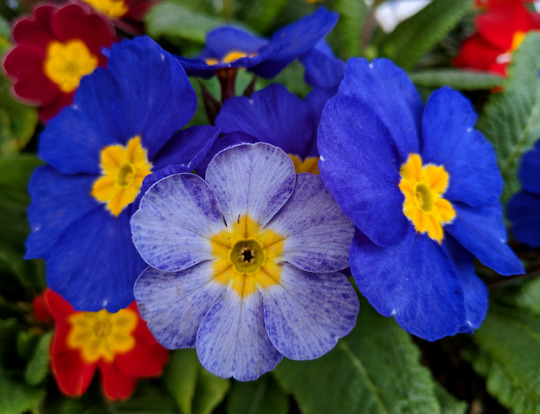


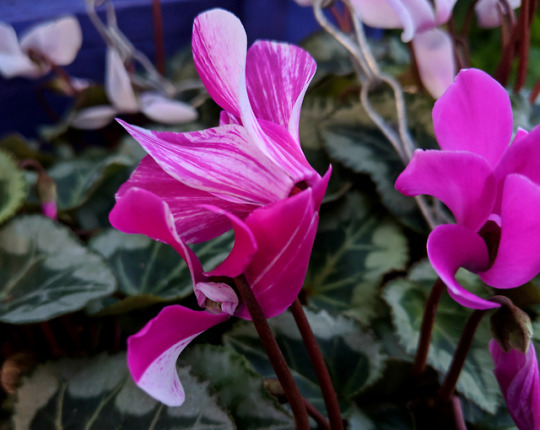

More plant oddities! Part 3
This has probably become my favourite series, it takes time to find new material for these posts but I hope it’s worth the wait!
- 10-tepalled Fritillaria michailovskyi, they generally have 6 tepals
- Non-variegated Arabis ‘Rose Delight’ sporting bright yellow variegation
- Hybrid Primula of the polyanthus group with only one oddly pigmented flower
- 8-petalled Cyclamen hybrid, surpassing the 7-petalled one from episode 2
- Hybrid pansy with the regular 5 petals, but forming two distinct flowers with their own sexual organs
- Hybrid Cylamen sporting a beautiful example of chimerism
- Celosia cristata sporting proliferation on top of the fasciation it has been selected for
Check the equally odd Part 1 & Part 2 and stay tuned for the next episode!
#plantblr#plants#plant oddities#weird plants#variegation#fasciation#proliferation#chimerism#flowers#horticulture#botany#fritillaria michailovskyi#arabis#primula#cyclamen#viola#celosia cristata
49 notes
·
View notes
Photo

Remember when I was hoping the record-breaking heatwave we had a couple of weeks ago wouldn’t be followed by more wintry weather? Well, this was my walk to work this morning…we also had freezing rain and hailstones, with a dash of sunlight. A typical March in Scotland.
You might recognise this landscape from my “The Luggie Water through the seasons” series, if not, check it out!
#snow#march#scotland#late winter#water landscape#luggie water#stream#burn#nature photography#winter weather#plantblr
52 notes
·
View notes